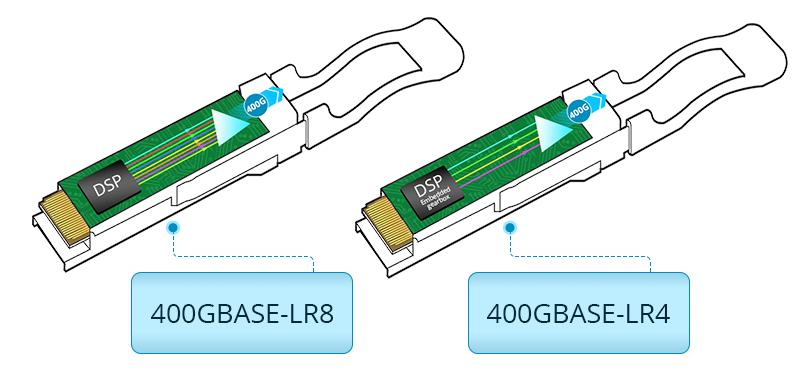400G Modules: Comparing 400GBASE-LR8 and 400GBASE-LR4
In cloud-scale data centers, increasing demands for bandwidth, capacity and latency are driving the migration to faster network speeds. During the past several years, link speeds throughout the data center have increased from 25G/100G to 100G/400G. 400G optical transceivers have attracted extensive attention, especially OSFP, QSFP-DD, and CFP8. FS 400G QSFP-DD LR4 and FS 400G QSFP-DD LR8 are designed uniquely, supporting not only high-speed optical transmission but also Long Range (LR) transmission, as shown in the following table.
| 400G QSFP-DD LR4 | 400G QSFP-DD LR8 | |
|---|---|---|
| Max Data Rate | 400Gbps | 425Gbps |
| Max Cable Distance | 10km | 10km |
| Media | SMF | SMF |
| Connector | LC Duplex | LC Duplex |
| Optical Modulation | 100G PAM4 | 50G PAM4 |
| Max Power Consumption | 12W | 14W |
| Protocol | 100Glambda MSA | IEEE 802.3bs |
FS 400G LR4 and LR8 transceivers are tailor-made for Data Center 400G Ethernet connections, offering impressive reach of up to 10km over SMF with duplex LC connectors. Not only do they excel in performance, but they're also engineered to thrive in challenging environments, handling extremes in temperature, humidity, and EMI interference effortlessly. However, it's important to note that the 400G LR4 and LR8 transceivers differ in their transmission modes, resulting in variations in power consumption, signal integrity, and more.
Difference between 400GBASE-LR4 and 400GBASE-LR8
The 400GBASE-LR8 is built with 8x EML lasers running at 50Gbps PAM4 while the 400GBASE-LR4 is built with 4x EML lasers operating at 100Gbps PAM4. But what's the real difference between 50Gbps PAM4 and 100Gbps PAM4?
Baud Rate
Baud is a unit representing the symbol rate and is becoming significantly important for 400G transmission. It's important to make a difference between baud rate and bit rate. Because PAM4 carries 2 bits per symbol. 50Gbps PAM4 (50 gigabit per second with PAM4 modulation) will have a line transmission at 25GBdps (Gigabaud per second). It means the symbol rate for 50Gbps PAM4 remains at 25 Gigabaud, while the symbol rate for 100Gbps PAM4 is 50 Gbaud.
In the case of the same packaging, photonic components, ASIC/DSP, and analog electronics, the transceivers with higher wavelength capacity or more bits per second can reduce cost per bit, power consumption, and footprint. Therefore, 400G QSFP-DD LR4 performs better than 400G QSFP-DD LR8 in terms of bit cost and power consumption.
Parallel Optic
The 400G transceivers (QSFP-DD and OSFP) always have 8 lanes of 50Gbps PAM4 on the electrical side. On the optical side, 400G QSFP-DD LR8 has 8 lasers of 50Gbps PAM4, and 400G QSFP-DD LR4 has 4 lasers of 100Gbps PAM4, requiring an electrical conversion (Gearbox) from 8×50Gbps PAM4 to 4×100Gbps PAM4. Relatively more lasers in 400G LR8 modules lead to higher production costs.

Pros and Cons
Although 400GBASE-LR8 (8×50Gbps PAM4) is now mature and ratified under IEEE 802.3bs, the 400GBASE-LR4 (4x 100Gbps PAM4) is favored for its cost benefits. 400G LR8 offers improved link budgets in some cases, but the total laser cost is higher and the optical packaging is more complex, causing lower output and higher production costs. In 400GBASE-LR4, data is transmitted at 100Gbps PAM4 per lane, considerably reducing the maximum optical reach and bringing extreme challenges to the signal integrity. A strong FEC mechanism will be required in 400G LR4 modules to bring the communication at a correct BER for a regular 400G connection. For example, FS 400G QSFP-DD LR4 has a host FEC to support up to 10km fiber transmission.
Present and Future Applications
The explosive traffic growth in cloud data centers has led to an increased demand for 400G optical modules. Featured with low-power, high-density, and high-speed, FS QSFP-DD LR4 and FS QSFP-DD LR8 are optimal for long-distance transmission in next-generation data centers.
Due to the differences mentioned above, the application of these two modules will change following the needs of data centers in the future. Compared with 8×50G modules, The 4×100G modules lower the power consumption, reduce the hardware complexity and relax the requirement on xWDM gird, even though they present a challenge in term of reach. Therefore, 400GBASE-LR4 may be mainstream for lower costs in the future. At the same time, the electrical port of 400GBSAE-LR4 may also be gradually upgraded to the form of 4×100G PAM4 to save power consumption and costs by eliminating the Gearbox.
You might be interested in
Email Address

-
PoE vs PoE+ vs PoE++ Switch: How to Choose?
Mar 16, 2023














